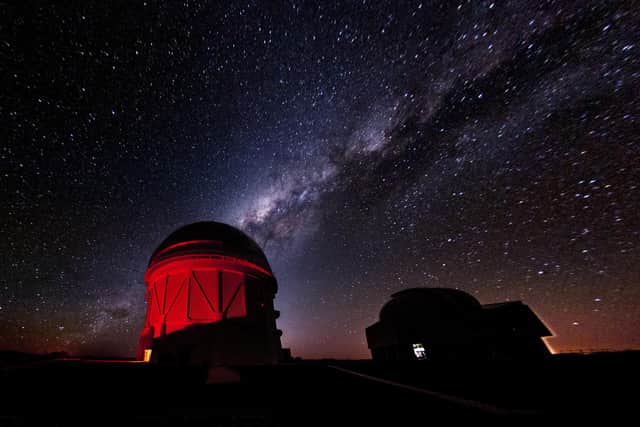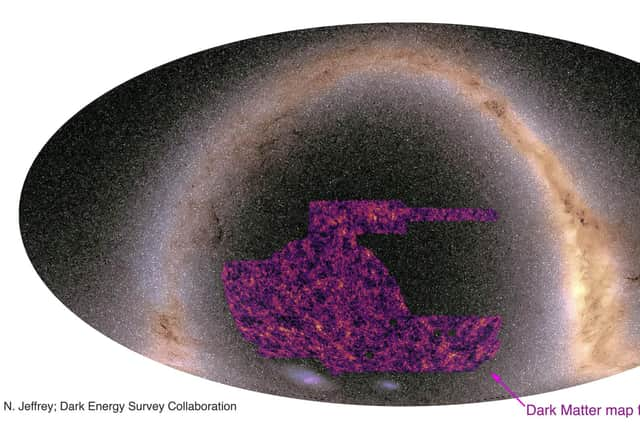What is dark matter in simple terms? New map of the night sky explained – and what it means for science
Researchers have created the largest ever map of dark matter, invisible material thought to account for up to 85 per cent of the total matter of the universe.
A team co-led by UCL researchers as part of the international Dark Energy Survey (DES), used artificial intelligence to analyse images of 100 million galaxies, looking at their shape, spots of light made up of 10 or so pixels, to see if they have been stretched.
Advertisement
Hide AdAdvertisement
Hide AdWe want to hear from you: let us know what you think about this story and be part of the debate in our comments section below


As matter curves space-time, astronomers are able to map its existence by looking at light travelling to Earth from distant galaxies. If the light has been distorted, this means there is matter in the foreground, bending the light as it comes towards us.
The new map – which is described in a new paper posted on the DES website and to be published in the Monthly Notices Of The Royal Astronomical Society – is a representation of all matter detected in the foreground of the observed galaxies, but covers just a quarter of the southern hemisphere’s sky.
But what is dark matter?
Here is everything you need to know.


What is dark matter?
For decades astronomers and scientists have suspected there is more material in the universe than we can see, estimating that up to 85 per cent of the mass in the universe is effectively invisible.
This dark matter cannot be observed directly because it does not interact with light in the same way as the ordinary matter that makes up stars, planets and life on Earth.
So in order to measure what cannot be seen, scientists analyse dark matter’s effect on gravity.
Dark matter, like dark energy, remains mysterious, but its existence is inferred from galaxies behaving in unpredicted ways, for instance, the fact that galaxies stay clustered together, and that galaxies within clusters move faster than expected.
Pol Gurri, a PhD student at Swinburne University of Technology, Australia, said: “It’s like looking at a flag to try to know how much wind there is – you cannot see the wind but the flag’s motion tells you how strongly the wind is blowing.”
Advertisement
Hide AdAdvertisement
Hide AdBut while scientists have observed the gravitational effects of dark matter for decades, its true nature still remains a mystery.
Questions around dark matter remain some of the deepest mysteries in modern physics, including what it is made of, and the imbalance of matter and antimatter in the universe.
These mysteries cannot be explained with the Standard Model, the guiding theory of particle physics which describes all the known fundamental particles that make up our universe and the forces that they interact with.
Some theories suggest the makeup of dark matter must be very cold and heavy, while others say it is composed of tiny particles which are so light that they behave like quantum matter and move in waves.
How was the study conducted?
Using artificial intelligence methods to study photographs from the Dark Energy Camera in Chile, researchers were able to reveal the shapes of hundreds of millions of distant galaxies.
Co-author Professor Ofer Lahav, UCL Physics and Astronomy, chairman of the DES UK consortium, said: “When we look at the night sky, we see the galaxy’s light but not the surrounding dark matter, like looking at the lights of a city at night.
“By calculating how gravity distorts light, a technique known as gravitational lensing, we get the whole picture, both visible and invisible matter.
What does the new map mean for science?
The study brings scientists closer to understanding what the universe is made of and how it has evolved.
Advertisement
Hide AdAdvertisement
Hide AdCo-lead author Dr Niall Jeffrey, UCL physics and astronomy, said: “Most of the matter in the Universe is dark matter. It is a real wonder to get a glimpse of these vast, hidden structures across a large portion of the night sky.
“In our map, which mainly shows dark matter, we see a similar pattern as we do with visible matter only, a web-like structure with dense clumps of matter separated by large empty voids.
“Observing these cosmic-scale structures can help us to answer fundamental questions about the universe.”
The analysis suggests matter is distributed throughout the Universe in a way that is consistent with predictions in the standard cosmological model, the best current model of the Universe.
Researchers also found hints that, as with previous surveys, the Universe may be a few per cent smoother than predicted, a prediction that comes from analysis of the light left over from the Big Bang.
A message from the editor:
Thank you for reading. NationalWorld is a new national news brand, produced by a team of journalists, editors, video producers and designers who live and work across the UK. Find out more about who’s who in the team, and our editorial values. We want to start a community among our readers, so please follow us on Facebook, Twitter and Instagram, and keep the conversation going.
Comments
Want to join the conversation? Please or to comment on this article.
